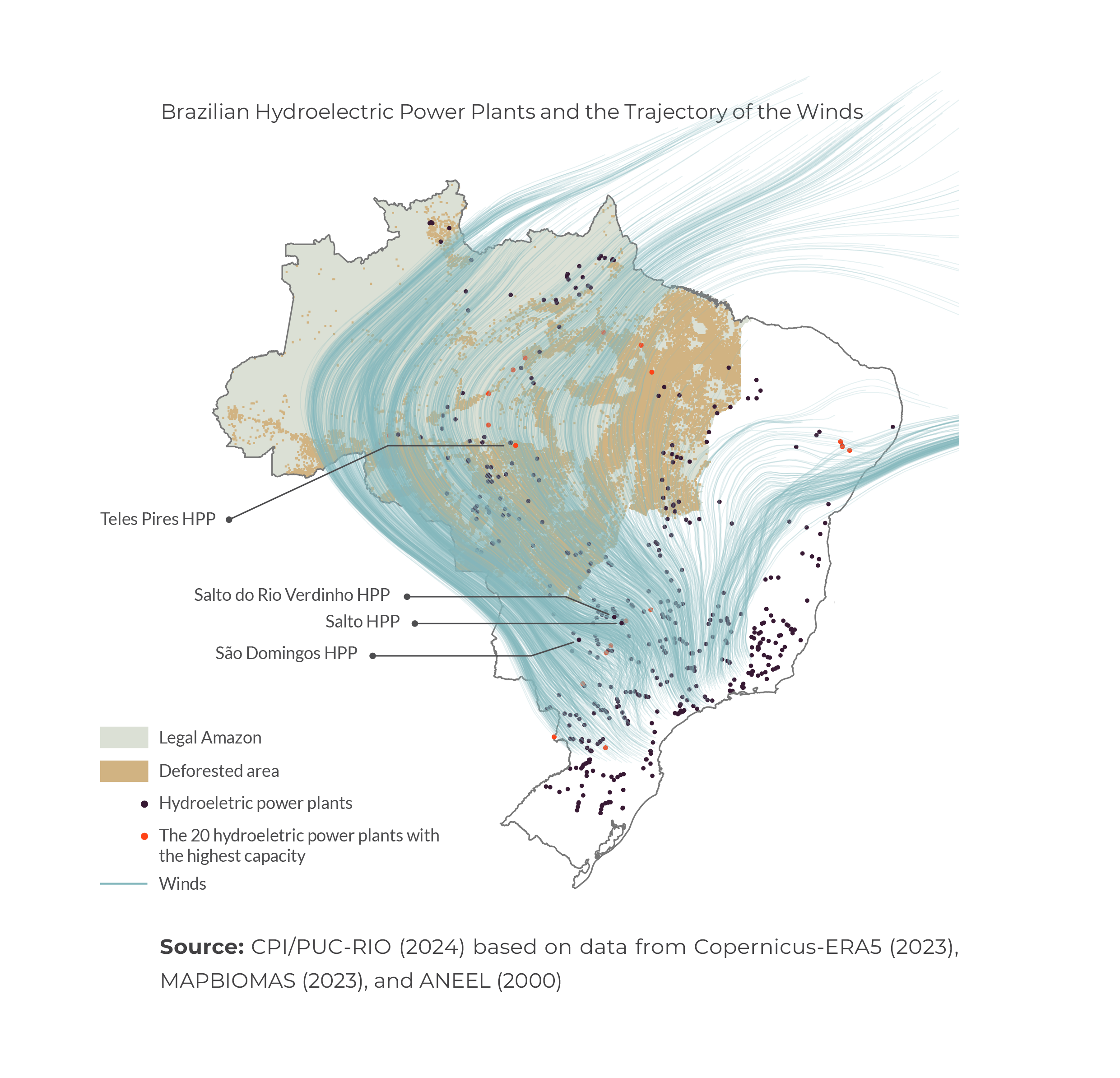New study estimates a loss of millions of reais for the electricity sector.
Deforestation in the Amazon rainforest could reduce Brazil’s power generation capacity and the profitability of the electricity sector by up to 10%, affecting even hydroelectric power plants (HPPs) located thousands of kilometers away from the Amazon biome. Of the 20 plants with the highest power generation capacity in Brazil, 17 are exposed to the flying river mechanism. This is the conclusion of a new study by Climate Policy Initiative/PUC-RIO and Amazon 2030.
“The impact of deforestation in the Amazon goes beyond the deforested area, producing negative effects in the environmental, social and economic spheres kilometers away from the biome. Forest conservation is of great importance for the national electricity matrix and for the country’s economy,” says Juliano Assunção, executive director of CPI/PUC-RIO and coordinator of Amazon 2030.
Hydroelectricity has been Brazil’s main source of energy generation, accounting for 60.2% of total energy generation in 2023. Researchers analyzed the effects of deforestation at the Teles Pires HPP, located in the Amazon region, and estimated an energy generation loss of 2.5% to 10%. This corresponds to the supply of electricity for at least 330,000 people. Considering the price of energy, deforestation has generated an average annual loss of USD 21 million.
However, the effects of deforestation on energy generation are not restricted to the limits of the Amazon biome. Researchers identified that the loss of vegetation affects the production of three HPPs, located in the Paraná Basin, thousands of kilometers from the forest. Even far from the Amazon biome, deforestation can cause a generation loss of around 3% and a potential 10% loss of annual profit for HPPs located in the Paraná Basin.
The potential loss for the Salto HPP, located in the state of Goiás, is approximately 13 GWh and USD 625,000 per year. The Salto do Rio Verdinho HPP, also in Goiás, has a potential loss of 9 GWh and USD 482,000 per year. The São Domingos HPP, located in the state of Mato Grosso do Sul, has a potential loss of 3.5 GWh and USD 232,000 per year.
“Combating deforestation is a matter of energy security. Given the importance of hydroelectricity in the Brazilian electricity matrix and the regions affected by the deforestation-loss of energy generation nexus, changes in rainfall patterns as a result of deforestation can significantly impact on the sustainability of the hydroelectric system at a large-scale,” says Gustavo Pinto, senior analyst at CPI/PUC-RIO.
In the long term, there could also be other impacts: an increase in the price of energy and greater demand for thermal power plants, with damage to the environment.
Forest and energy generation
The Amazon rainforest significantly influences rainfall patterns through a mechanism known as flying rivers.
“Flying rivers are moisture-laden air currents that carry water from the Amazon and run east of the Andes in a north-south direction, ensuring the supply of rivers and the irrigation of crops. When air currents pass through deforested areas, they lose moisture more easily, which reduces the incidence of rain along the air currents’ path. As a result, the flow of rivers is reduced, which decreases the capacity of hydroelectric power plants,” explains Assunção.
The study points out that the air currents coming from the Atlantic Ocean cross the Amazon and then pass through regions where a substantial number of Brazil’s HPPs are located. The loss of forest vegetation directly impacts the productivity of 17 of the country’s 20 largest capacity plants, as shown in the figure below.

Researchers have identified that preserving the forest area that most influences electricity generation at the Teles Pires HPP is worth an average of USD 2,382/km². By focusing on the 5% of forest area most relevant to the plant’s power generation, the value of conservation rises to USD 6,000/km².
In relation to the plants located in the Paraná Basin, the values for the 5% most relevant forest area for power generation at the São Domingos, Salto and Salto do Rio Verdinho HPPs are USD 11/km², USD 25/km², and USD 19/km², respectively.
“Mapping the main points in the Amazon that contribute to maintaining the country’s energy security is crucial for directing policies to conserve and protect the national electricity matrix. It is also important that agents in the electricity sector participate in forest conservation and restoration,” says Pinto.
The study also analyzed land tenure categories in the forest area that most influence electricity generation from the HPPs. In the case of Teles Pires HPP, Indigenous Land is the main land tenure category (41.6%), followed by undesignated forest (18.5%). In the case of the Paraná Basin HPPs, private rural properties registered under Brazil’s Land Management System (SIGEF) are the main category (40%), followed by Indigenous Lands (20%).
“The Amazon is made up of a mosaic of land categories. In this sense, it’s crucial to consider land tenure categories for targeting the most effective policies and finance mechanisms for conserving and/or restoring the most relevant areas for energy generation, which are suited to the needs of each context,” says Joana Chiavari, research director at CPI/PUC-RIO.
About Climate Policy Initiative
Climate Policy Initiative (CPI) is an organization with international expertise in finance and policy analysis. CPI has seven offices around the world. In Brazil, CPI has a partnership with the Pontifical Catholic University of Rio de Janeiro (PUC-RIO). CPI/PUC-RIO works to improve the effectiveness of public policies and sustainable finance in Brazil through evidence-based analysis and strategic partnerships with members of the government, civil society, the private sector and financial institutions.
For more information, please contact
Camila Calado Lima
camila.lima@cpiglobal.org
+55 86 99966-0560

